Traditional Spoon Styles and Shapes
Naturally, I think of a large, medium deep bowled, oval spoon when I think about working a wooden spoon carving project. But carving spoons is so much more when you consider the huge range of kitchen tools and utensils that can be created with a bent round gouge, a bench knife, and a draw knife.
Let’s explore some of the possible carving projects you can work when you take up spoon carving. All of the spoons, forks, knives, scoops, and spatulas patterns shown here are available in Lora S. Irish’s newest book – The Art of Spoon Carving – at Amazon.com.
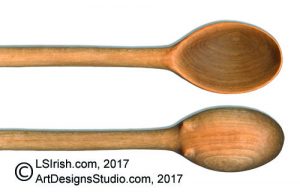 The large mixing spoon, above, is as classic and traditional
The large mixing spoon, above, is as classic and traditional
a spoon style that you can carve. It has a medium-deep, oval shaped
bowl, with an extra thick handle that can tackle the hardest
dough or batter mix. The two ears on the back side of the
bowl keep the spoon from rolling when it rests on
on the kitchen counter.
Large Kitchen Spoons
In the photo, below, you will see at the top a wide, flat batter spoon. The bowl area is about 3″ wide and 1/2″ in thickness. Its total length is 12″ from spoon tip to handle tip. Acting like a shovel, the wide, flat spoon area lifts and folds large amounts of flour into your bread batter.
The center spoon has an extra deep bowl that measures 2″ wide by 3″ long, which makes it a soup or stirring spoon. It also is cut from a 12″ long carving wood blank. The depth of the bowl evenly mixes the carrots, beans, and potatoes in your favorite bean soup recipe.
The paddle spoon, shown at the bottom of the photo, was found in just about every farm house up until the end of the 20th century. It was used to stir the kettle as the apple butter thickened or as the family cook rendered the pork fat for soap making. Carved from a 5″ wide x 12″ long x 1 1/2″ thick basswood board, this spoon can handle several gallons of apple butter at a time.
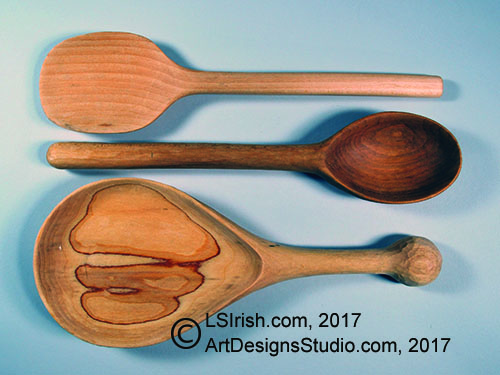 Shown above from top to bottom – bread batter spoon,
Shown above from top to bottom – bread batter spoon,
soup stirring soup, and apple butter paddle. While I have
worked my spoons from 12″ long blanks, traditionally
this style of spoon could have handles up to 18″ or longer.
Medium Sized Kitchen Spoons
Any of the spoons in the photo below would have been found in your grandmother’s spoon jar. The first spoon on the left is a dipping spoon. The medium-sized deep round bowl is perfect for scooping out lard from the can to throw into the cast iron skillet.
Second from the left is a straight-edged spoon that let her scrap the rounded corner of her sauce pans while her puddling thickened on the stove. That straight cornered bottom edge drops wonderfully against the bottom of the pan and reaches right into the pan’s corner to get every little bit of pudding.
A flour scoop is shown in the center of the photo. Grandmom could lift spoonfuls of flour, sugar, and even dried barley and then be use to stir the ingredient into her mix.
The fourth spoon is also a scoop that features a wider and lower opening along the front of the spoon’s edge. The lower scoop profile makes this tool perfect for picking up butter, moist brown sugar, and even molasses.
Our final scoop, shown far right, is a mixing scoop but I use mine to stir and flip hash browns in the iron skillet. The center portion of the scoop is flat; only the outer edges of the scoop roll and lift above the floor of the skillet. That profile works well for picking up, and flipping large portions of small cut pieces.
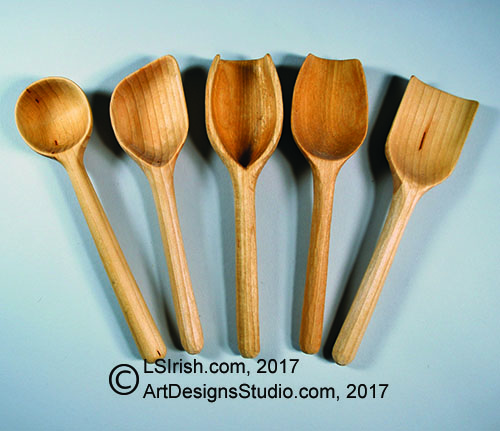 From left to right – dipping spoon, straight-edged spoon,
From left to right – dipping spoon, straight-edged spoon,
flour scoop, wet ingredients scoop, and a flipping scoop.
Traditionally these spoons have bowl areas that are one-third
the total length of the spoon. These are worked from
1″ x 3″ x 10″ basswood blanks.
Specialty Spoons
Every cook seems to have their favorite specialty spoon in the spoon jar on the stove. Let’s take a moment and look at just a few.
Slotted spoons are common tools around the kitchen, but this slotted spoon with its single center hole is used to lift pickles or olives from the jar while draining away the juice. Shown left in the photo, the hole is made by up-ending your favorite large round gouge, and twirling the gouge in a circle until you cut through the bowl.
Oh, that slotted draining spoon today is just perfect for getting the purple-red pickled eggs out of the jar!
The thumb print at the joint of the handle in this wooden blade lets you get a close grip on the knife as you spread the icing on your chocolate cake. While not common in today’s kitchen, wooden knives were often found in the pre-20th century spoon jar. My knife sample has a triangular shape which let’s it spread the beaten egg whites evenly over your lemon pudding pie. Long, rounded-end knives similar to a palette knife were also common and used to scrap along the walls of pickle jars or deep canning crocks.
The center tool in the photo is a fun specialty fork made specifically to lift and turn bacon in the frying pan. The front edge of the fork is extremely thin, so that it slips under the bacon strip easily. The center hole that creates the two tines of the fork lets the extra grease drain.
Folding stiffened egg whites into your next salmon soufflé batter is easy with this flat, long oval folding spoon. Note that in this spoon style the bowl area is one-half or longer than the total length of the spoon to give you lots of extra working room.
Sometime you just need a hard-working spoon that will turn or mix those extremely thick batters. The spoon, shown far right, is just this type. Its short handle lets me get a tight grip, close to the batter. Its extra thick, low sweep bowl stands up to the hard pressure needed to work that last little bit of flour into the bread dough.
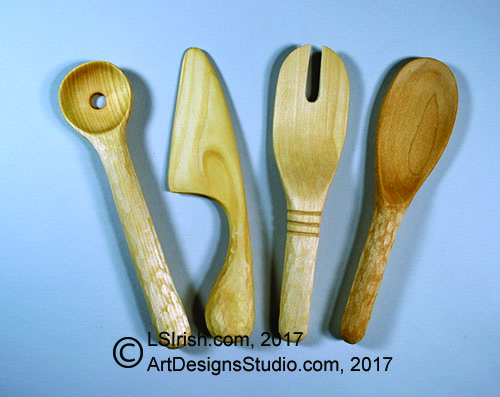 Shown from left to right – slotted draining spoon, cake icing knife,
Shown from left to right – slotted draining spoon, cake icing knife,
bacon fork, and a thick batter spoon. All of these are short handled
spoons cut from 1″ x 2-3″ x 8″ basswood blanks.
Specific Purpose Spoons
While most of our wooden spoons, forks, and ladles are made to do a specific task in the kitchen as mixing, draining, measuring, or lifting the spoons in the photo below were created to accommodate specific cans, jars, or kitchen equipment
World War I saw the introduction of mass produced canned food for both the soldiers overseas and the home front. The top spoon in the photo comes directly from that era and was used to scoop the lard out of the new tins. These tins were wide and low so a short handle easily reached the bottom of the tin and the thick bowl was strong enough to lift the lard.
If you carve no other spoon than the second spoon in this photo every cook that you know will praise your carving skills. This is an all-purpose oven rack spoon. The bowl shape can be used to fold, mix, or scoop. The handle is long enough to use in any sauce pan or deep cooking bowl. But it is the handle end that is most noteworthy. The hook on the handle is used to slip over a hot oven rack letting you pull it safely from the oven and the cut half-circle in the end goes against the outer rail of the rack so that you can push that hot rack back into the oven for more baking. A cook can do just about every job in the kitchen with this one spoon.
Large flat bowls and forks are the hallmark of salad serving spoons. Because these are lifting spoons, not stirring spoons, their handles easily accept decorative and curved style handles.
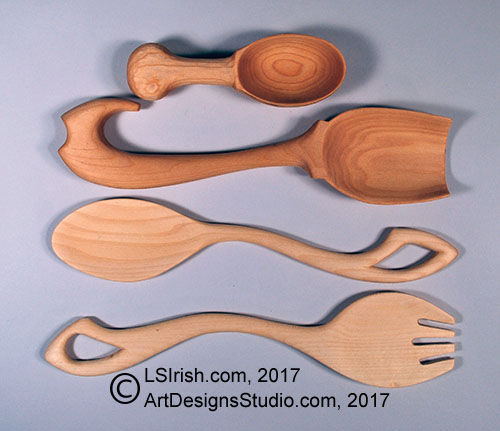 Shown top to bottom – lard tin spoon, oven rack spoon,
Shown top to bottom – lard tin spoon, oven rack spoon,
and a set of modern-styled salad spoons.
Mix & Match Spoon Carving
Once you learn the simple steps to carving your spoon bowl, fork tines, and handles styles you will be ready to create your own unique style of kitchen tools.
This fun set of barbecue and picnic spoons was carved from 1/2” thick by 3” wide by 6” long basswood and took about one hour of carving for each utensil. Shallow and short, they are perfect to throw on your picnic table, ready to scoop up relish, pickles, and mustard.
These are so fun to make and takes maybe one night’s carving each to create that I quickly found myself with an entire shoe box full of little spoons. Plus the small size means that you can practice, explore, and experiment with different bowl shapes easily.
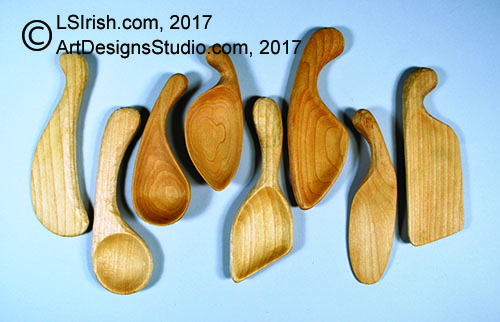 From left to right – mayo knife, pickle spoon, sauce spoon,
From left to right – mayo knife, pickle spoon, sauce spoon,
bean salad spoon, two straight-edges spoons, flipping spatula,
and a lifting spatula. This set of barbecue spoons were worked from
1/2″ x 3″ x 6″ basswood blanks.
Left & Right Handled Utensils
Curved spoon handles should be adapted to the individual user and the curvature determines which hand holds the spoon. In this photo the two spoons on the left are shaped to fit left handed chiefs who move the spoon in a counter clockwise motion.
The two spoons on the right are made for right handed cooks. Any curved pattern can be reversed to make it either right or left handed.
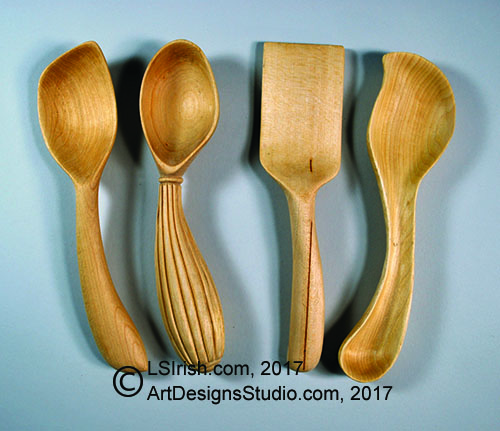 The curve of the handle and the opening or point of the bowl of
The curve of the handle and the opening or point of the bowl of
your hand-carved wooden spoon determines whether the utensil is
made for a left or right handed cook.
All of the spoons, forks, knives, scoops, and spatulas patterns shown here are available in Lora S. Irish’s newest book – The Art of Spoon Carving – available at Amazon.com.